Chorion gonadotropin. Chorionic gonadotropin - official instructions for use
Testosterone production plays an important role in the functioning of the body of men and women. The drug Chorionic Gonadotropin in the form of injections, according to the instructions for use, solves an important problem - to increase its level in case of deviation from the norm. What other effect does the drug have, for what problems is it prescribed, how to use it correctly - this is discussed in detail in the annotation.
What is human chorionic gonadotropin
This is the name of the hormone responsible for puberty and reproductive function. What is hCG for a woman’s body? This is a substance that is actively produced after the fertilization of the egg. It belongs to the gonadotropic hormones, but differs in the sequence of amino acids. Exceeding the hCG norm confirms pregnancy. This is determined by a pharmacy test that reacts to its content in the urine. An increase in hCG in non-pregnant women may indicate the presence of a malignant tumor.
The administration of the drug causes an increase in the production of sex hormones in men, the development of secondary sexual characteristics, and stimulates sperm activity. During use in women:
- the production of estrogen and progesterone by the ovaries increases;
- ovulation is stimulated;
- the function of the corpus luteum is normalized;
- coming proper development placenta.
Composition and release form
Gonadotropin is available as two components, packaged in a box. Each contains 5 sets of medicine. The composition has:
- Solvent – physiological sodium chloride solution with a concentration of 0.9%.
- A sterile glass bottle with a substance in the form of a white powder contains 500 or 1000 IU - action units. The basis is human chorionic gonadotropin, obtained from biological material, which has undergone a process of lyophilization - drying in a vacuum. An auxiliary component is mannitol.
Pharmacological action
Recombinant human chorionic gonadotropin is a hormone that is produced by the placenta and is excreted from the body in the urine of a pregnant woman, from where it is extracted to obtain medicine. When administered by intramuscular injection, it produces healing effect. Active ingredient:
- after 15 minutes it enters the bloodstream;
- distributed in tissues;
- excreted in urine;
- half-life is 8 hours.
The drug Gonadotropin refers to the hormones of the hypothalamus:
- In women - normalizes ovarian function, activates the formation of the corpus luteum, stimulates the production of progesterone and estrogens. Application promotes luteinizing effect - the correct process of ovulation.
- Gonadotropin for men helps the formation of secondary sexual characteristics and stimulates spermatogenesis. The drug accelerates the descent of the testicles into the scrotum in the treatment of cryptorchidism and activates the production of the hormone testosterone.
Indications for the use of human chorionic gonadotropin
- infertility as a consequence hormonal disorders;
- late puberty in girls and boys;
- dysfunction of offspring reproduction;
- decreased synthesis of sex hormones.
For men
A decrease in gonadotropin levels creates serious problems in the body. HCG in men is responsible for sperm activity and the production of sex hormones. The drug is prescribed if:
- cryptorchidism;
- reproductive dysfunction;
- insufficient activity of the gonads;
- testicular hypoplasia;
- spermatogenesis disorders;
- phenomena of eunuchoidism;
- hypogenitalism.
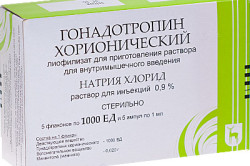
For women
The hormone gonadotropin plays an important role in the treatment of female infertility caused by dysfunction of the corpus luteum. It helps to get pregnant in the absence of ovulation, when the follicle cannot burst to fertilize the egg. Indications for use of the product by women are:
- ovarian dysfunction;
- uterine bleeding during childbearing years;
- threat of miscarriage in the first trimester;
- violations, lack menstrual cycle.
Instructions for use of human chorionic gonadotropin
The medicine is prescribed intramuscularly. How to inject gonadotropin? The method and duration of the course are determined by the doctor, which depends on the disease and the planned result. Duration of therapy is up to 45 days. There are features:
- In men, treatment with the drug is used 3 times a week for a month, the dose is up to 3000 IU. Next comes a six-week break and a new course. This can be repeated 3 times in a year.
- The medicine is prescribed to boys with cryptorchidism at a dosage of 1000 IU twice a week for a month and a half. Several courses are offered.
Treatment for women depends on the problem:
- to stimulate ovulation - one injection of 10,000 IU;
- if there is a threat of miscarriage, 10,000 IU are administered for the first time, then 5,000 IU twice a week;
- in case of anovulatory dysfunction with high estrogen levels, the injection is carried out on the 10-12th day of the menstrual cycle, dose - 3000 IU, 2-3 injections with an interval of several days;
- to normalize the production of the corpus luteum - up to 5000 IU on the 3rd, 6th, 9th day after ovulation.
In bodybuilding
The use of gonadotropin by athletes along with the use of steroids has mixed reviews. Professionals do not confirm high results after taking hormonal drugs. Gonadotropin in bodybuilding with large dosages provokes dysfunction of the testicles, hypothalamus, and pituitary gland. There are groups of bodybuilders who use the product for a long time and note:
- obtaining beautiful muscle relief;
- increasing endurance during training;
- stimulation of spermatogenesis;
- increased sexual desire.
During pregnancy
Caution should be exercised when treating with gonadotropin during pregnancy. Gynecologists prescribe medicine in exceptional cases, the course is carried out in a hospital setting under the strict supervision of a doctor. When using the drug, there may be adverse effects on the body of a pregnant woman:
- increased risk of miscarriage;
- development multiple pregnancy.
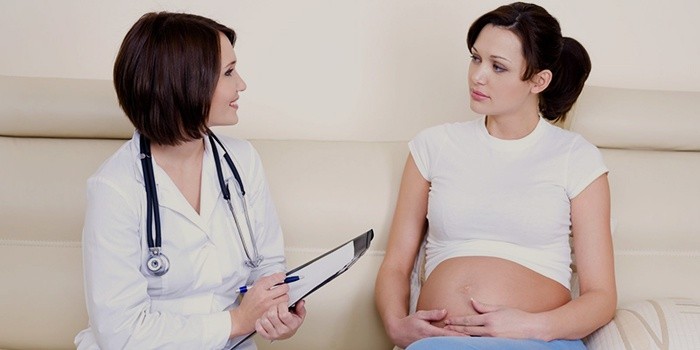
Special instructions
Instructions for use require that interactions between gonadotropic hormones and glucocorticosteroids be excluded. Long-term administration of the drug can lead to the formation of antibodies to it. Special instructions during use:
- Driving a car or working on equipment that requires high concentration is not recommended;
- combination with alcohol is not recommended;
- When treating men, the level of androgens increases - medical supervision is necessary.
The summary of the drug specifies important points:
- solution for injection is prepared before use, storage is unacceptable;
- if ovarian hyperstimulation syndrome occurs, treatment must be stopped;
- you need to stop feeding during treatment during lactation;
- with prolonged administration, the functions of the pituitary gland decrease;
- The medicine cannot be used after the expiration date.
Side effects of human chorionic gonadotropin
It is unacceptable to self-medicate; in case of overdose, serious side effects are inevitable. Unpleasant symptoms can affect many systems. In this case, the body reacts:
- weakness;
- depression;
- irritability;
- headache;
- increased fatigue;
- anxiety;
- weight gain;
- allergy;
- antibody formation;
- pain at the injection site;
- enlargement of the mammary glands;
- fever;
- rash;
- swelling.
It is possible that side effects from the genitourinary system in case of violation of the administered dose of human chorionic gonadotropin:
- in women – multiple pregnancy, ovarian hyperstimulation syndrome, the appearance of ovarian cysts, peripheral edema;
- in boys – early puberty, acne formation;
- in men - atrophy of the seminiferous tubules, prostatic hyperplasia, enlargement of the testicles, penis, increased sensitivity of the nipples.
Contraindications for human chorionic gonadotropin
The instructions for use stipulate contraindications for taking the drug. You need to be careful about this to avoid trouble. The use of the drug is prohibited in the following cases:
- high sensitivity to components;
- cancerous tumors of the genital organs, breast;
- thrombophlebitis;
- pituitary tumors;
- hypothyroidism;
- hypertension;
- migraines;
- epilepsy;
- adrenal insufficiency;
- premature puberty in boys;
- heart failure, renal dysfunction in men.
Among the contraindications for administering the medicine, there are additional restrictions for women:
- improperly formed genitals that prevent you from getting pregnant;
- ovarian failure;
- fibrous tumor of the uterus incompatible with pregnancy;
- bleeding, discharge of unknown origin;
- severe obesity;
- breastfeeding period.
Analogs
Gonadotropin is part of the group of drugs that regulate hormonal disorders. There are medications with similar effects that are only suitable for solving problems female body associated with low concentrations of hCG. These include Puregon, Ovitrel, Pergoveris. Hormonal agents used in the treatment of men and women:
- Ecostimulin;
- Horagon;
- Decayed;
- Menopur;
- Prevasi.
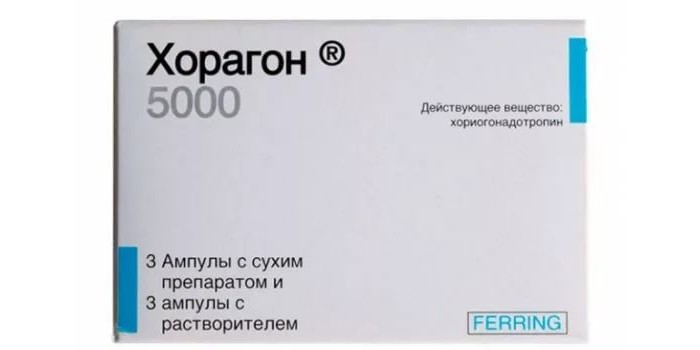
Price for human chorionic gonadotropin
Gonadotropin and analogues are sold by pharmacies. You can order hCG drugs through websites and buy them from online drug stores. The cost depends on the product and dosage; it may increase due to transportation costs. The price range for Moscow pharmacies is in rubles:
| ME Action Units | Dosage, ml | Quantity, pieces | Price range, rub. |
|
| Human chorionic gonadotropin | ||||
| Puregon lyophilisate | ||||
| Ovitrel, 250 mg | ||||
The pharmacological group of the substance human chorionic gonadotropin includes several hormones of the hypothalamus, pituitary gland, progestogen and their antagonists.
This is a placental hormone with two subunits alpha and beta - essentially homologous alpha is intensely luteinizing, the beta subunit stabilizes and balances the follicle-stimulating effect of alpha. Chorionic gonadotropin is an antihormonal luteinizing drug used only in injection solutions. Initially it is a white sterile powder.
When is a human chorionic gonadotropin test needed?
Human chorionic gonadotropin is produced from the urine of pregnant women. It is produced biologically from the placenta. The level of this substance fluctuates throughout pregnancy, starting at about 3 weeks. Medical constant monitoring of the production of human chorionic gonadotropin during pregnancy helps to timely detect dysfunction of the gonads and prevent the threat of miscarriage or ectopic attachment. Natural antibodies to gonadotropin are present in the body of any person, some have them in normal quantities, others have a highly developed erroneous immune structuring. For women, they can block the activity of a hormonal drug, depleting the nutrition of the placenta, inhibiting the secretion of the corpus luteum in the presence of estrogenic ovarian function. An increased level of antibodies can have a detrimental effect on the intrauterine development of the fetus; in this case, plasmapheresis is sometimes recommended by the attending physician.
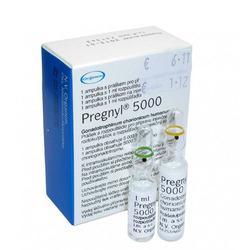 In non-pregnant women, indications for the use of gonadotropin may include anovulatory ovarian dysfunction, dysfunctional uterine bleeding, etc.
In non-pregnant women, indications for the use of gonadotropin may include anovulatory ovarian dysfunction, dysfunctional uterine bleeding, etc.
For men, human chorionic gonadotropin is prescribed for primary dysfunction of the pituitary gland, for genetic disorders with testicular hypoplasia, acquired hypogenitalism, adiposogenital syndrome, oligospermia, bilateral cryptorchidism, etc. It has the necessary gonadostimulating effect on the functionality of the gonads.
How to use?
Human chorionic gonadotropin (hCG), according to current tests, may be exceeded due to the complicated course of pregnancy. For example, in the case of low and weak attachment of the placenta, its insufficiency, latent infection in the uterus or congenital chromosomal disease of the fetus. The human chorionic gonadotropin formula is included in the pregnancy test. The level of its increased activity in the urine indicates successful conception. You need to test your urine regularly from the moment you register at the clinic. If the period is determined incorrectly, deviations from the norms in the content of human chorionic gonadotropin in the placenta are possible. The instructions for use do not say anything about this, so timely consultation with a knowledgeable geneticist is extremely important. He will prescribe human chorionic gonadotropin during pregnancy.
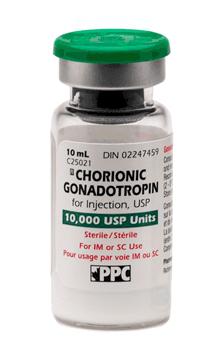
The drug can also be effective in case of infertility due to pituitary-avorial dysfunction, various disorders of the natural functions of the ovaries, in the presence of a threat of miscarriage, in case of risk of termination of pregnancy by forced abortion, in the diagnosis of low chances of successfully bearing a child. Use strictly as prescribed by a qualified physician. But human chorionic gonadotropin is prescribed, the price of which is approximately 700 rubles per set, not only for pregnant women, but also for men and adolescents who have problems with hormonal levels.
Reception and doses
The dosage regimen for human chorionic gonadotropin during a risky pregnancy is controlled by a doctor. In the first 8 weeks, 10,000 IU is prescribed one day if there is insufficiency in the urine, then 5,000 IU in the form of injections up to 14 weeks, twice a week. Boys are given an injection of human chorionic gonadotropin for delayed sexual development, 3000 IU once a week for three months. Men are prescribed human chorionic gonadotropin 5000 IU once or for 1.5-2 months, depending on the type of disease.
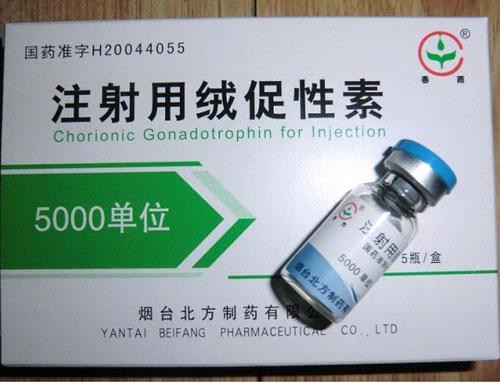
How the drug works
The pharmacological interaction of human chorionic gonadotropin with integral glycoproteins activates the functionality of the adenylate cyclase structure, promotes follicular transformation into the corpus luteum, induces ovulation, helps the implanted egg to adapt, and supports poor development of the placenta. In men, the drug qualitatively produces testosterone and stimulates the development of secondary sexual characteristics.
Intramuscular injections of human chorionic gonadotropin normalize hormonal levels. Meanwhile, the rational use of this substance is very important; the instructions must be fully followed. Overdose caused by incorrect diagnosis leads to negative consequences.
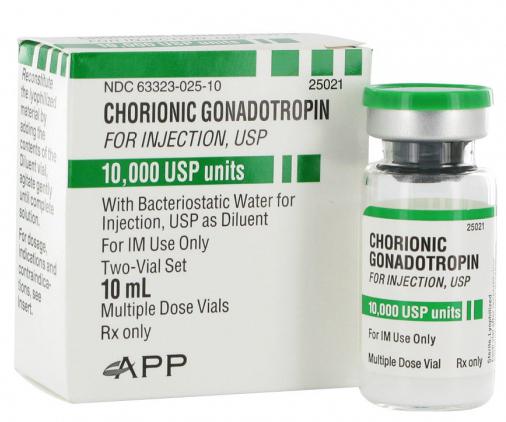
Contraindications
The instructions do not prescribe the use of human chorionic gonadotropin for current tumors of the genital organs, for any inflammatory processes, with bronchial asthma, prostate cancer, renal and heart failure, since excessive formation of antibodies suppresses the gonadotropic functionality of the pituitary gland, which is extremely contraindicated in these diseases. In rare cases, allergic reactions are possible, provoking enlargement of the ovaries in women and testicles in men, and the progression of prostatitis in the latter.
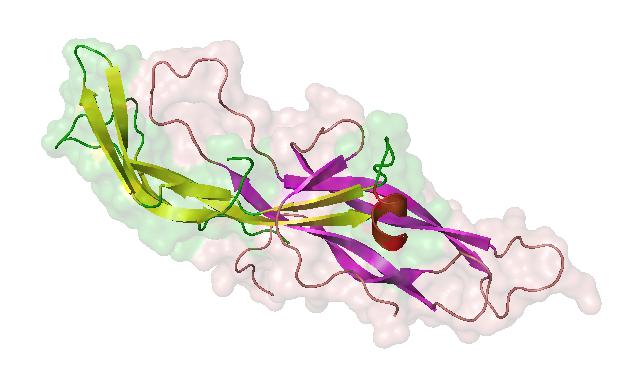
Packaging, composition
The packaging of the drug “Human Chorionic Gonadotropin” includes a white lyophilized powder of 500 or 1000 IU and a solution of isotonic sodium chloride 0.9% in 1 ml ampoules. There are exactly 5 pieces in the set. The instructions recommend storing human chorionic gonadotropin in a dark place with a temperature no higher than 20 o C.
Precautions
Under no circumstances should the drug be used after the expiration date. Keep away from children. Human chorionic gonadotropin is strictly contraindicated in children under 14 years of age. Use with caution in patients with arterial hypertension and adolescents in puberty.
Analogs
Chorionic gonadotropin (instructions are always included with the medication) is part of a single pharmacological group with such drugs as the synonyms "Pregnil" and "Choragon". The first is a remedy for the treatment of hormonal disorders, it stimulates the intensity of steroidogenesis in the gonads, effective in forced combination with the drug "Puregon" to induce ovulation. Sold in ampoules of 1500 IU (3 bottles per package) at a price of 1300 rubles. Due to its price and composition, human chorionic gonadotropin is much more popular among consumers compared to analogues.
The drug "Choragon" is a synonym for human chorionic gonadotropin and has a similar composition with excipients (sodium hydroxide, etc.). Cost - about 2 thousand rubles. per set. The medication significantly increases the likelihood of multiple pregnancies in women, and in men an excessive occurrence of natural antibodies is possible.
Chorionic gonadotropin: reviews
The drug is not used for such common phenomena as early menopause, postoperative or congenital absence of the gonads, or obstruction of the fallopian tubes. Also, for thrombophlebitis and coronary heart disease, this substance, according to doctors, is irrelevant.
Chorionic gonadotropin 1000 units. and more is prescribed strictly individually by the attending physician. Independent use is fraught with aggravation of sexual dysfunction and general disorders of the body systems.
The drug "Chorionic Gonadotropin" has earned positive reviews. The main condition for proper use is a qualified diagnosis and appropriate combination with other medications. You should not take the medicine for a long time; breaks in use are required. Chorionic gonadotropin, the price of which is affordable (from 400 rubles), is in deserved demand. All this information must be discussed during a consultation with a geneticist.
If the amount of human chorionic gonadotropin is artificially exceeded, local reactions and allergic side effects are possible, such as:
- headache;
- increased anxiety;
- untimely depression;
- irritability;
- swelling of the genital organs;
- acute increase in nipple sensitivity;
- the presence of excess fluid in the abdominal and chest cavities.
Only if reactions are minimized, and in most cases are absent, then a high-quality diagnosis was carried out and the appropriate dosage of the drug was prescribed.
Finally

Interesting fact: previously, human chorionic gonadotropin, the instructions for which contained little information, was mistakenly considered a useful nutritional supplement that stabilized the general condition of the body, but subsequent studies refuted this characteristic. This substance is considered a purely medicinal drug aimed at combating the capricious hormonal system. Therefore, it is prohibited to use it for other purposes.
Preparations containing Chorionic Gonadotrophin (ATC code G03GA01):
| Common forms of release (more than 100 offers in Moscow pharmacies) | |||||
|---|---|---|---|---|---|
| Name | Release form | Packaging, pcs. | Country, manufacturer | Price in Moscow, r | Offers in Moscow |
| powder for injection 500 units in ampoules | 5 | Russia, MEZ | 275-(average 338↘)-568 | 483↗ | |
| Chorionic Gonadotrophin | powder for injection 1 thousand units in ampoules | 5 | Russia, different | 353- (average 544↘) -665 | 602↗ |
| Rarely encountered forms of release (less than 100 offers in Moscow pharmacies) | |||||
| Name | Release form | Packaging, pcs. | Country, manufacturer | Price in Moscow, r | Offers in Moscow |
| Chorionic Gonadotrophin | powder for injection 5 thousand units in ampoules | 5 | Russia, MEZ | 1795- (average 1829) -2100 | 27↘ |
| Pregnyl | powder for injection 1.5 thousand IU in 2 ml ampoules | 3 | Netherlands, Organon | 1075- (average 1189) -150 | 55↘ |
| Pregnyl | powder for injection 5 thousand IU in ampoules 2 ml | 1 | Netherlands, Organon | 194-(average 400) -850< | 55↗ |
| Choragon | powder for injection 1.5 thousand IU in 1 ml ampoules | 3 | Germany, Ferring | 830- (average 930↘) -1250 | 76↗ |
| Choragon | powder for injection 5 thousand IU in ampoules 1 ml | 3 | Germany, Ferring | 1200- (average 1820↗) -2000 | 51↗ |
Pregnil (Chorionic Gonadotropin) - official instructions for use. The drug is a prescription, the information is intended only for healthcare professionals!
Clinical and pharmacological group
Recombinant human chorionic gonadotropin.
Pharmacological action
The drug Pregnil contains hCG (human chorionic gonadotropin). This hormone has biological activities similar to those of LH (luteinizing hormone). LH is indispensable for the normal growth and maturation of female and male gametes and for the formation of sex hormones.
For women:
- Pregnil is used as a substitute for the mid-cycle surge of endogenous LH to induce the final phase of follicular maturation leading to ovulation. The drug Pregnil is also used as a substitute for endogenous LH during the luteal phase.
For men and boys:
- The drug Pregnil is used to stimulate Leydig cells to accelerate the process of testosterone formation.
Pharmacokinetics
The maximum concentration of hCG in the blood plasma after a single intramuscular or subcutaneous injection of hCG is achieved after 6-16 hours in men and approximately 20 hours in women. Although there is high individual variability, sex differences in the rate of absorption of the drug after a single intramuscular injection are most likely associated with the greater thickness of subcutaneous fat in women. Approximately 80% of hCG undergoes metabolic transformations in the kidneys. It has been established that a single IM or subcutaneous injection of hCG is bioequivalent with respect to the duration of absorption and the apparent half-life of approximately 33 hours. Given the recommended dosing regimens and half-life, accumulation of the drug is not expected.
Indications for use of the drug PREGNIL®
For women:
- induction of ovulation in case of infertility caused by anovulation or impaired follicle maturation;
- preparation of follicles for puncture in controlled ovarian hyperstimulation programs (for assisted reproduction techniques);
- maintaining the corpus luteum phase.
For boys and men:
- hypogonadotropic hypogonadism;
- delayed puberty due to insufficiency of the gonadotropic function of the pituitary gland;
- cryptorchidism not due to anatomical obstruction.
Dosage regimen
After adding the solvent to the lyophilisate, the reconstituted Pregnil solution is slowly injected intramuscularly or subcutaneously.
For women:
- when inducing ovulation in case of infertility caused by anovulation or impaired follicle maturation, one injection of the drug Pregnil is usually performed in a dose of 5,000 to 10,000 IU to complete treatment with follicle-stimulating hormone (FSH);
- when preparing follicles for puncture in programs of controlled ovarian hyperstimulation;
- to maintain the corpus luteum phase, two to three repeated injections of the drug can be given at a dose of 1000 to 3000 IU each within 9 days after ovulation or embryo transfer (for example, on days 3, 6 and 9 after ovulation induction).
For boys and men:
- for hypogonadotropic hypogonadism: 1000-2000 IU of Pregnil 2-3 times a week. In case of infertility, it is possible to combine the drug Pregnil with an additional drug containing follitropin (FSH) 2-3 times a week. The course of treatment should continue for at least 3 months before any improvement in spermatogenesis can be expected. Testosterone replacement therapy must be suspended during this treatment. When improvement in spermatogenesis is achieved, in some cases, isolated use of hCG is sufficient to maintain it;
- with delayed puberty caused by insufficiency of the gonadotropic function of the pituitary gland 1500 IU 2-3 times a week. The course of treatment is at least 6 months;
- with cryptorchidism not caused by anatomical obstruction;
- at the age of up to 2 years: 250 IU is administered twice a week for 6 weeks;
- at the age of up to 6 years: 500-1000 IU is administered twice a week for 6 weeks;
- over the age of 6 years: 1500 IU is administered twice a week for 6 weeks.
The course of treatment can be repeated if necessary.
Side effect
Immune system disorders: In rare cases, a generalized rash or fever may occur.
General disorders and conditions at the injection site: When using the drug Pregnil, reactions may occur at the injection site, such as bruising, pain, redness, swelling and itching. Allergic reactions have been reported in some cases, most of which include pain and/or rash at the injection site.
For women:
Vascular disorders: In rare cases, thromboembolism has been associated with FSH/hCG therapy, usually associated with severe ovarian hyperstimulation syndrome (OHSS).
Respiratory, thoracic and mediastinal disorders: hydrothorax as a complication of severe OHSS.
Gastrointestinal disorders: Abdominal pain and gastrointestinal symptoms such as nausea and diarrhea associated with mild OHSS. Ascites as a complication of severe OHSS.
Reproductive system and mammary gland disorders: unwanted ovarian hyperstimulation, moderate or severe OHSS; breast tenderness, mild to moderate ovarian enlargement and ovarian cysts associated with moderate OHSS; large ovarian cysts (prone to rupture), usually associated with severe OHSS.
According to the study results: weight gain is a sign of severe OHSS.
For men and boys:
Metabolic and nutritional disorders: in some cases, when high doses are administered, water and sodium retention are observed; it is thought to occur as a result of excess androgen production.
Reproductive system and mammary gland disorders: HCG treatment can sporadically cause gynecomastia.
Contraindications to the use of PREGNIL®
- hypersensitivity to human gonadotropins or to any component of the drug;
- established or suspected tumors dependent on sex hormones (ovarian cancer, breast cancer and uterine cancer in women and prostate cancer, breast cancer in men).
For boys (optional):
- premature puberty;
For women (additionally):
- abnormal formation of the genital organs, incompatible with pregnancy;
- fibrous tumor of the uterus, incompatible with pregnancy.
With caution:
Women with risk factors for thrombosis (personal or family history, severe obesity (body mass index >30 kg/m2) or thrombophilia) may have an increased risk of venous or arterial thromboembolism during or after treatment with gonadotropins. In these women, the benefits of in vitro fertilization (IVF) therapy need to be assessed and possible risks. It should be noted that pregnancy itself is also accompanied by an increased risk of thrombosis.
In men and boys: Treatment of male patients with hCG results in increased androgen production.
- patients with latent or overt heart failure, renal impairment, arterial hypertension, epilepsy or migraine (or a history of these conditions) should be under strict medical supervision, since exacerbation of the disease or relapse can sometimes be the result of increased androgen production;
Use during pregnancy and lactation:
The drug Pregnil can be used to maintain the function of the corpus luteum of the ovary, but cannot be used during pregnancy. Pregnil should not be used during lactation.
Use during pregnancy and breastfeeding is contraindicated.
Use for renal impairment
Patients with impaired renal function (or a history of this condition) should be under strict medical supervision, since exacerbation of the disease or relapse can sometimes result from increased androgen production.
Use in children
Possible use in children according to indications.
Contraindicated in boys with premature puberty.
HCG should be used with caution in prepubertal boys to avoid premature closure of the epiphyses or precocious puberty. Skeletal development should be monitored regularly.
Special instructions
For women:
- during pregnancy that occurs after ovulation induction with gonadotropic drugs, there is an increased risk of multiple pregnancy;
- Since infertile women undergoing assisted reproductive technologies, and in particular in vitro fertilization, often have disorders of the fallopian tubes, the incidence of ectopic pregnancies may increase. Therefore, early ultrasound confirmation that the pregnancy is intrauterine is important;
- the incidence of pregnancy loss in women undergoing assisted reproductive technologies is higher than in the general population;
- the presence of uncontrolled extragonadal endocrinopathies (for example, diseases of the thyroid gland, adrenal glands or pituitary gland) should be excluded;
- The incidence of congenital malformations after assisted reproductive technologies (ART) may be slightly higher than as a result of spontaneous conceptions. This slightly increased incidence is thought to be related to parental characteristics (maternal age, semen characteristics) as well as the high incidence of multiple pregnancies after ART. There is no indication that an increased risk of congenital malformations is associated with the use of gonadotropins during ART;
- unwanted ovarian hyperstimulation:
- in patients receiving combination therapy with FSH/hCG for infertility caused by anovulation or impaired follicular maturation, the use of an FSH-containing drug may lead to unwanted ovarian hyperstimulation. Therefore, before starting FSH treatment and at regular intervals during FSH treatment, ultrasound examinations should be performed to assess follicular development and estradiol levels should be measured. Estradiol levels can rise very quickly, for example, more than a daily doubling may be observed over two or three consecutive days, and can reach extremely high levels. The diagnosis of unwanted ovarian hyperstimulation can be confirmed by ultrasound. In the event of unwanted ovarian hyperstimulation (i.e. not as part of treatment aimed at preparing for in vitro fertilization with embryo transfer (IVF/ET), intratubal gamete transfer (GIFT) or intraplasmic sperm injection (ICSI)), administration of FSH-containing the drug must be stopped immediately. In this case, it is necessary to avoid pregnancy and not administer the drug Pregnil, since the administration of LH-active gonadotropin at this stage can cause, in addition to multiple ovulation, OHSS. This warning is especially important for patients with polycystic ovaries. Clinical symptoms of moderate OHSS include gastrointestinal disturbances (pain, nausea, diarrhea), breast tenderness, and mild to moderate ovarian enlargement and ovarian cysts. Transient abnormalities in liver function tests indicative of hepatic dysfunction, which may be accompanied by morphologic changes on liver biopsy, have been reported to be associated with OHSS.
In rare cases, severe OHSS occurs, which can be life-threatening. It is characterized by large ovarian cysts (prone to rupture), ascites, mass gain, often hydrothorax, and in some cases thromboembolism; - Pregnil should not be used for weight loss. HCG has no effect on fat metabolism, fat distribution, or appetite.
Impact on the ability to drive vehicles and operate machinery
According to available data, the drug does not affect the speed of psychomotor reactions and concentration.
Overdose
The acute toxicity of gonadotropin preparations obtained from human urine has been shown to be very low. However, there is a possibility that too high a dose of hCG may lead to OHSS.
Drug interactions
Since the interaction of Pregnil with other drugs has not been studied, such an interaction cannot be excluded.
During treatment with Pregnil and for 10 days after stopping treatment, it may affect the values of immunological tests for hCG levels in serum/urine, which may lead to a false-positive pregnancy test result.
Conditions for dispensing from pharmacies
The drug is available with a prescription.
Storage conditions and periods
The drug should be stored at a temperature of 2 to 15°C, protected from light. Keep out of the reach of children. Shelf life - 3 years. Do not use after expiration date.
The instructions are quoted from the pharmaceutical website
Formula: Human chorionic gonadotropin in its chemical structure is a glycoprotein consisting of two subunits: alpha and beta. The α-subunit of human chorionic gonadotropin is completely homologous to the α-subunits of luteinizing, follicle-stimulating and thyroid-stimulating hormones. The β-subunit of hCG is unique to this hormone and distinguishes it from LH, FSH and TSH. Human chorionic gonadotropin consists of 237 amino acids.
Pharmacological group: hormones of the pituitary gland, hypothalamus, gonadotropins and their antagonists/gonadotropic hormone.
Pharmacological action: luteinizing, gonadotropic.
Pharmacological properties
Human chorionic gonadotropin binds to specific receptors on the membranes of gonad cells (which are integral glycoproteins with a molecular weight of about 194,000), activates the adenylate cyclase system and reproduces the same effects as luteinizing hormone, synthesized in the anterior pituitary gland. In women, it stimulates and induces ovulation, stimulates the rupture of the follicle and its transformation into the corpus luteum, including when performing additional reproductive methods; increases the functional activity of the corpus luteum in the luteal phase of the menstrual cycle, prolongs its existence, inhibits the onset of the menstrual phase, enhances the formation of androgens and progesterone, including in case of corpus luteum deficiency, helps implantation of the egg and supports the formation of the placenta. Ovulation usually occurs 32–36 hours after injection.
In men, it stimulates the work of testicular Leydig cells, increases the formation and production of testosterone, helps in spermatogenesis, the development of secondary sexual characteristics and the descent of the testicles into the scrotum.
Human chorionic gonadotropin is well absorbed into the blood when administered intramuscularly. With systematic use, the content in the blood gradually increases, and by 7–12 days it exceeds the initial level by one and a half times. It has two half-life phases - 11 and 23 hours. It is excreted unchanged by the kidneys during the day, 10–12% of the dose. Does not have a mutagenic effect. Dose-dependently increases the incidence of congenital external anomalies in mice. May cause adverse effects on the fetus when used in pregnant women.
Indications
Reduced functioning of the gonads due to disorders in the hypothalamus-pituitary gland system: in women - infertility caused by pituitary-ovarian dysfunction, including after preliminary stimulation of endometrial proliferation and follicle maturation, menstrual irregularities (including its absence), uterine dysfunction bleeding during childbearing years, insufficient function of the corpus luteum, threatened and habitual miscarriage in the 1st trimester of pregnancy, controlled “superovulation” during artificial insemination; in men - the phenomena of eunuchoidism, hypogonadotropic hypogonadism, testicular hypoplasia, hypogenitalism, adiposogenital syndrome, cryptorchidism, spermatogenesis disorders (azoospermia, oligospermia).
Method of administration of human chorionic gonadotropin and dose
Human chorionic gonadotropin is administered intramuscularly. Women- when using methods of artificial insemination and to stimulate ovulation: 5000–10000 IU a day after the last use of urofollitropin or menotropins, or 5–9 days after the last use of clomiphene; in case of insufficient function of the corpus luteum - 1500 IU every second day, it is worth starting from the day of ovulation until the day of expected menstruation or until pregnancy is confirmed (if pregnancy is confirmed, repeated use is possible up to 10 weeks of pregnancy).
Men- for hypogonadotropic hypogonadism, 2–3 times a week, 1000–4000 IU for several weeks or months or until therapeutic effects are obtained; in case of infertility to stimulate spermatogenesis for six months or more; if the number of sperm in the ejaculate remains low (less than 5 million/ml), therapy is supplemented with urofollitropin or menotropins and treatment is continued for another 1 year. In prepubertal age cryptorchidism - 2–3 times a week, 1000–5000 IU until the desired effect is obtained, but not more than 10 doses; to identify hypogonadism in young men - for 3 days, 2000 IU 1 time per day.
If you miss the next dose of the drug, you should immediately consult a doctor.
Solutions must be prepared directly in isotonic sodium chloride solution before use. It is worth considering the possibility of false-positive results of immunological tests for the content of endogenous human chorionic gonadotropin and the possibility of increased levels of 17-ketosteroids and 17-hydroxycorticosteroids in the urine. Therapy should be carried out under the supervision of a qualified physician who has experience in treating endocrine diseases and disorders. When used to stimulate ovulation, an individual choice of doses and regimen of use of the drug is required and their correction depending on the results; ultrasound of the ovaries, regular measurements of the content of progesterone and estradiol in the blood serum, and daily monitoring of basal temperature body and compliance with the sexual activity regime recommended by the doctor. When cysts form in the ovaries or the development of ovarian hypertrophy, temporary cessation of therapy is necessary (to avoid cyst rupture), a reduction in the dose of the drug for the next course, and abstinence from sexual intercourse. With severe ovarian hypertrophy or a strong increase in the content of estradiol in the blood serum on the last day of therapy with urofollitropin or menotropins, stimulation of ovulation in this cycle are not carried out.
When treating infertility in men, it is worth measuring the testosterone content in the blood serum before and after using the drug, as well as determining the motility and number of sperm. In case of premature puberty during therapy for cryptorchidism, treatment should be discontinued, then other methods of therapy are used. If there is no dynamics of testicular descent after using 10 doses of the drug, then continuing therapy is not recommended. Diagnosis of hypogonadism in young men is carried out by monitoring the concentration of testosterone in the blood serum before use and one day after the course of therapy. An unreasonable increase in the duration or dose of use of the drug may be accompanied by a decrease in the number of sperm in the ejaculate of men.
Contraindications for use
Hypersensitivity (including hypersensitivity to other gonadotropins), tumors or hypertrophy of the pituitary gland, inflammatory diseases or hormone-dependent tumors of the genital organs, renal and heart failure, epilepsy, bronchial asthma, migraine; in women - threat or syndrome of ovarian hyperstimulation, uterine fibroid, undiagnosed dysfunctional uterine bleeding, hypertrophy or ovarian cyst, which is not associated with its polycystic disease, exacerbation of thrombophlebitis; in men - premature puberty (for the treatment of cryptorchidism), prostate cancer.
Restrictions on use
To stimulate ovulation - polycystic ovary syndrome. Age up to 4 years (efficacy and safety have not been determined).
Use during pregnancy and breastfeeding
During pregnancy, it is necessary to take into account possible adverse effects on the fetus (according to the results obtained when using the drug in pregnant women and experimental animals). Breast-feeding It is worth stopping during therapy.
Side effects of human chorionic gonadotropin
Nervous system: headache, anxiety, irritability, fatigue, depression, weakness;
allergic reactions: angioedema, rash, dyspnea;
genitourinary system: in women - the formation of ovarian cysts, ovarian hypertrophy, ovarian hyperstimulation syndrome, peripheral edema, multiple pregnancy;
in men- enlargement of the testicles in the inguinal canal, which complicates further descent of the testicles, premature puberty, atrophy of the seminiferous tubules, degeneration of the gonads;
others: enlargement of the mammary glands, formation of antibodies (with prolonged use), pain at the injection site.
Interaction of human chorionic gonadotropin with other substances
Combined use with urofollitropin and menotropins increases the severity of ovarian hyperstimulation syndrome, the possibility of pregnancy and premature birth.
Overdose
In women, when ovulation is stimulated at the beginning of menstruation, acute ovarian hyperstimulation syndrome may spontaneously develop. Symptoms: nausea, sharp pain in the abdominal cavity (groin area), vomiting, bloating, diarrhea, decreased urine output, swelling lower limbs, rapid breathing, in severe cases - blood thickening, hypovolemia, ascites, electrolyte imbalance, peritonitis, acute pulmonary failure, hydrothorax, thromboembolic phenomena. Necessary: temporary withdrawal of the drug, hospitalization (if necessary), symptomatic treatment (correction of blood clotting, water-salt balance and other disorders).
A healthy body in men is capable of healing itself and rid itself of various problems. Its regeneration and eternal youth of the male body depend on the full functioning of the germ cells in the testicles and the production of testosterone. You can regain your health, get rid of pain, and get a lot of energy by using human chorionic gonadotropin for men. Reviews from people who have experienced its effects help to gain a positive attitude before starting treatment.
Which drug should I choose to start therapy?
Chorionic gonadotropin is a special hormone of the placenta. It simultaneously includes the properties of luteinizing hormone, synthesized in the pituitary gland. The active ingredient of the drug is choreogonadotropin. It is part of medicines produced under different names in the UK, France, Germany:
- "Gonakor".
- "Rotten."
- "Ecostimulin".
 All of the above drugs are capable of:
All of the above drugs are capable of:
- increase the production of sex steroids;
- regulate spermatogenesis;
- develop secondary sexual characteristics.
The drug is used in men with altered functions of the gonads with the development of disorders in the hypothalamic-pituitary system. In boys, human chorionic gonadotropin is prescribed for late puberty, cryptorchidism, etc. Men use medicinal product when there is a violation of the formation of sperm in germ cells.
The active ingredient, human chorionic gonadotropin, is available in the form of solutions or dry powder, in ampoules or vials. The therapeutic dose of the drug is determined biologically by studying abnormalities in the sperm analysis of a sick man.
For what pathology in men is gonadotropin used?
 The doctor prescribes the drug for pathology of the genital organs detected in the male body during examination. The use of gonadotropin for treatment brings quick and good results. Chorionic gonadotropin is prescribed for a course of therapy and, if necessary, supplemented with other drugs that have a general strengthening effect, vitamins, etc.
The doctor prescribes the drug for pathology of the genital organs detected in the male body during examination. The use of gonadotropin for treatment brings quick and good results. Chorionic gonadotropin is prescribed for a course of therapy and, if necessary, supplemented with other drugs that have a general strengthening effect, vitamins, etc.
Men often complain about the lack of male-pattern hair on the face and body. Their testosterone levels are low, several times less than normal. The drug, prescribed by a specialist, corrects the production of testosterone, affecting the reproductive cells.
Gonadotropin after a course of treatment in men causes headache attacks that last up to 30-60 minutes and occur repeatedly during the day.
Athletes' interest in gonadotropin
Athletes use gonadotropin to participate in many types of sports. Some of them do not note the normalizing effect of gonadotropin on the condition of their body, but at the same time pay great attention to the issue of building muscle mass.
Many athletes adjust their training and nutrition regimen while taking the drug. The end result is moderate muscle growth throughout their body. Athletes take gonadotropin to restore the shape of the testicles and their original size.
Injectable forms of gonadotropin do not negatively affect men's health and have a positive effect on the development of secondary sexual characteristics. In men, there is a high amount of testosterone formed as a result of the use of gonadotropin, and a maximum concentration of anabolic steroids in the blood.
Many men, as a result of intense exercise combined with the simultaneous use of anabolic steroids, experience a decrease in sexual desire. Experienced athletes are familiar with this problem and take appropriate measures in advance to solve the psychological difficulties that arise. They use gonadotropin regularly, at regular intervals. As a result of the course of treatment, spermatogenesis and libido are completely restored.
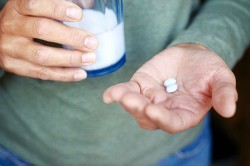 The male body needs a strictly defined medication intake, coinciding with the end of taking steroid hormones. Gonadotropin increases the amount of testosterone in the short term, but is not able to completely inhibit the loss of muscle mass and strength when steroid treatment is completed. As a result of this process, athletes experience mental instability. To relieve painful symptoms, they use gonadotropin, prescribed by a doctor during the period of complete cessation of hormone intake.
The male body needs a strictly defined medication intake, coinciding with the end of taking steroid hormones. Gonadotropin increases the amount of testosterone in the short term, but is not able to completely inhibit the loss of muscle mass and strength when steroid treatment is completed. As a result of this process, athletes experience mental instability. To relieve painful symptoms, they use gonadotropin, prescribed by a doctor during the period of complete cessation of hormone intake.
After consuming gonadotropin, the male body completely restores the amount of testosterone in the testicles. However, it does not have a significant effect on the hypothalamus and pituitary gland, and testosterone reduces the production of luteinizing hormone.
After completing the course of treatment with gonadotropin, athletes must undergo a recovery period. They can correct impaired spermatogenesis associated with long-term steroid hormone therapy. Men involved in bodybuilding note the positive effect of gonadotropin on muscle hardness and the volume of subcutaneous fat.
In some men, the amount of subcutaneous fat does not decrease after using the drug, and appetite or fat distribution does not change.
An important quality of gonadotropin is that the drug has a biphasic effect.
The main stages of the action of gonadotropin on the human body
 After taking the drug in any dosage, a two-phase increase in the amount of testosterone in a man’s body is observed. The level of elevation depends on the dose of medication used. The main purpose of gonadotropin administration after steroid use is to maintain muscle mass levels.
After taking the drug in any dosage, a two-phase increase in the amount of testosterone in a man’s body is observed. The level of elevation depends on the dose of medication used. The main purpose of gonadotropin administration after steroid use is to maintain muscle mass levels.
In men, gonadotropin, when used in doses prescribed by a doctor, does not cause dependence on the drug. Some patients develop antibodies in their bodies that affect the effectiveness of the medicine. The course of treatment is established by the attending physician and is strictly individual for each patient. Positive results appear over a long period of time, due to the fact that gonadotropin promotes the rapid division of germ cells and affects their number.
In some cases, in men who have used the drug for a long time, the testicles suspend their function, reducing the production of luteinizing hormone. As a result of treatment, hypofunction of the gonads occurs.
In athletes who have used the hormone for a long time, the body stops producing gonadotropins for a long time. In some cases, gonadotropic receptors are completely destroyed in a man’s testicles and the testicles become resistant to the hormone.
Side effects associated with the administration of human chorionic gonadotropin
 The use of the drug causes side effects similar to those after the use of testosterone. The level of estrogen in the male body increases depending on the amount of testosterone and causes the growth of mammary glands in the stronger sex. The most common side effects after administration of the drug can appear at any stage of its use and manifest themselves as:
The use of the drug causes side effects similar to those after the use of testosterone. The level of estrogen in the male body increases depending on the amount of testosterone and causes the growth of mammary glands in the stronger sex. The most common side effects after administration of the drug can appear at any stage of its use and manifest themselves as:
- increased libido;
- presence of acne;
- retention of mineral salts and water in the body.
Violation of water and mineral balance leads to the appearance of edematous muscles of the body. In men with high testosterone levels, after additional administration of gonadotropin, the water balance is disturbed and unhealthy obesity develops.
Testosterone in their body is converted into female sex hormones, estrogens. In young men, after using the medicine, bone growth stops, blood pressure decreases, and the timbre of the voice is impaired. Some men experience nausea, vomiting, a feeling of lightheadedness, and unmotivated fullness after using the drug.
Aging men during menopause suffer from a 30% drop in testosterone levels. They need to correct the level of the hormone in the blood and consult a doctor for a course of treatment with gonadotropin.
In patients prone to baldness, the therapeutic effect of the hormone prevents the appearance of baldness. The medicine is used carefully, under strict medical supervision. Self-medication can seriously harm a man’s body. As a result of improper therapy, he develops cosmetic defects:
- acne;
- acne;
- sebaceous plugs.
When prescribing chronic gonadotropin, the patient should be aware of the possibility of the formation of an oncological process, which occurs in rare cases after therapy.
Chronic gonadotropin can rejuvenate the male body, improve the condition of all organs and systems, and improve the quality of life.




